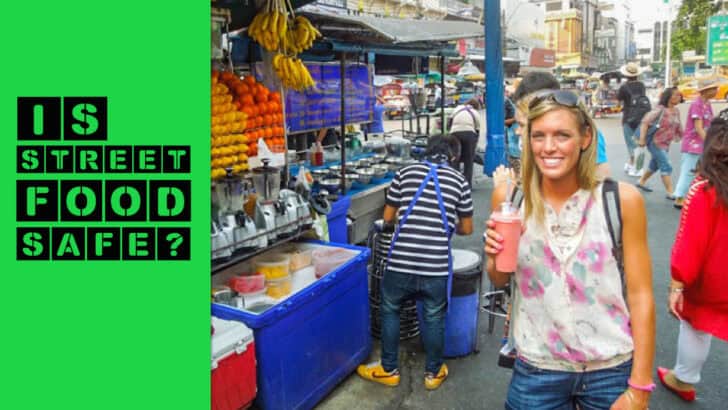Working the last 10+ years at a meat processing plant has done two things for me: #1 Worked me to the point of burnout and ultimately pushed me to take our RTW trip. Secondly, has given me more knowledge than most people would care to have on food-borne pathogens (Food Bugs).
Please don’t hate me for working in an industry that has a less than stellar reputation. Before you click off this article for principal reasons, I swear to use my knowledge for the good of travel and to help you tell when is street food safe.
I did not major in microbiology, but I have spent weeks in training classes listening to the experts on how it affects food. I am going to avoid most of the painfully boring details, and just try and give you some real-life advice that I use when judging is street food safe.
I will be skipping the goofy names of all the harmful little guys that can be in your food, I will simply call them “Bugs”. The term bugs will refer to all of the headliner sicknesses causes like Salmonella, E Coli, Campylobacter, and any of their nasty friends.
Now before you think I am anti-street food, I truly believe that street food is most times safer than restaurant food in much of the world. I am going to show you how I look at the world of street food using only two concepts: Time & Temperature. I have tried to put a common-sense approach to each in order for you to gauge your risks.
Contents:
- 1.) Temperature vs. Time and Street Food
- 2.) Example 1 – Is this Street Food Safe?
- 3.) How Time affects Street Food Part 1?
- 4.) Example 2 – Is this Street Food Safe?
- 5.) How Time affects Street Food Part 2
- 6.) Are cold foods from street vendors safe?
- 7.) Is fruit bought from street vendors safe?
- 8.) Is dried street food safe?
- 9.) Safe Street food
Food Temperature
As far as temperature goes food needs to be one of two ways to be safe, hot or cold. It’s simple, below 40F (4C) food bugs won’t grow. Above 140F (60C) they begin to die, then they all die at 160F (71C).
Typically street foods (with the exception of fruits and a few others, covered later) are served hot. How hot is the key to food safety, the number you need to remember is 160F (71C). This is the temperature that will kill ALL harmful bugs in your food.
Unless you walk around with a meat thermometer in your pocket this may be hard to judge. Just use your head if you see your vendor making a batch and the ingredients are sitting in bubbling oil for several minutes you are most likely to temp.
The size of the pieces is important to how quickly it will cook all the way through. The smaller the piece the faster it will cook. Large or thicker cuts will take much longer than smaller bite-size cuts.
If you are unsure ask them to cook it longer, longer is always better when it comes to food bugs. Another way to check is to take the largest or thickest piece and cut (or bite if no knife is available, which is often the case); if the color is consistent from the inside to outside, it’s likely cooked enough.
If the meat has the bone, check the color/temperature closest to the bone in the thickest part. This should be the area to get up to temperature last. It can be assumed that if this area is properly cooked, the rest will be, too.
Is this Street Food Safe?
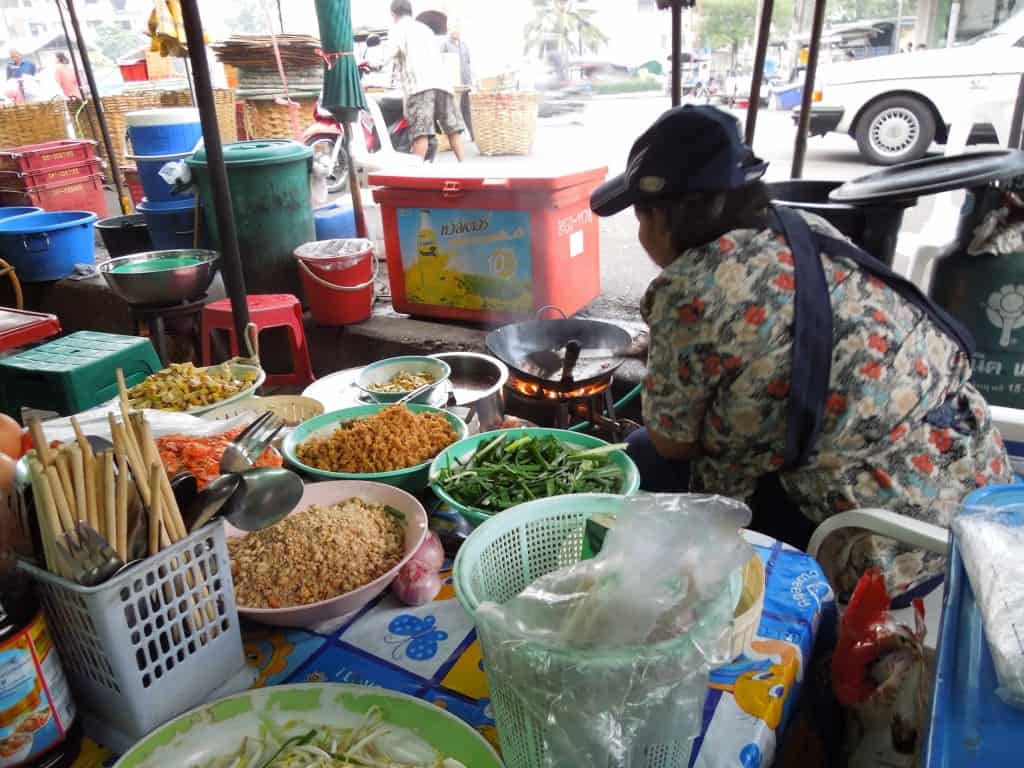
Let’s take a closer look at this stall and see why it looks like a safe place to eat:
- She is cooking to order – Good
- All ingredients are stored separately – Good
- Cook station appears to be clean and orderly – Good
- Pad Thai is a low-risk dish, to begin with, because the ingredients aren’t contaminated easily (except if fresh shrimp is used)
Temp tip: Gauging Temperature – Food at 160F (71C) will burn your tongue! If you don’t need to let it cool for a little bit before eating, it wasn’t hot enough to begin with!
Time
We are going to look at time in two different ways. First, in terms of freshness. In the case of meat, before the animal is taken for its meat, the meat is not contaminated. Where the bugs can be introduced is in the butchering and the practices used.
Since when evaluating a street food cart, you won’t know if this was all done properly, we have to assume the meat has some level of bacteria on it. Don’t freak out about this, even the meat in the fancy grocer back at home has some on it too. So, to ensure the meat you are about to eat is safe is it has to be cooked to a certain temperature that we talked about above.
However, that’s not the end of it. The environment will recontaminate the food even after properly cooking, especially sitting street side. As time passes from cooking, the amount of harmful bugs is growing. Fresh from the grill is the best, an hour or two isn’t ideal but unlikely to get you sick (assuming it’s cooked properly), half a day or overnight has a high potential to get you sick. This is all a numbers game, and since you don’t always know how well the food was cooked, you need to insist on it being fresh.
If a vendor is preparing the food to order, my risk factor drops quickly (provided it gets hot enough). The ones that scare me are the pre-made dishes that are kept warm and then served. How long has that been sitting there? I don’t know, but if it isn’t kept above 140F (60C), you could have some risk.
We are going to talk temp again quickly; prime growing temperatures for food bugs are 70F (21C) to 135F (57C). So if they are holding your food in that temperature range, they could be incubating the bugs in your meal.
The moral of this story is to find a cart, make it order, or find a busy cart. A popular vendor means two things: 1.) The food isn’t given time to grow enough bacteria to hurt you 2.) It’s popular for a reason; the food probably tastes GOOD!
If you find yourself in Bangkok, make sure to read our What to Eat in Bangkok Guide, which is full of great Thai street food items.
Is This Street Food Safe?
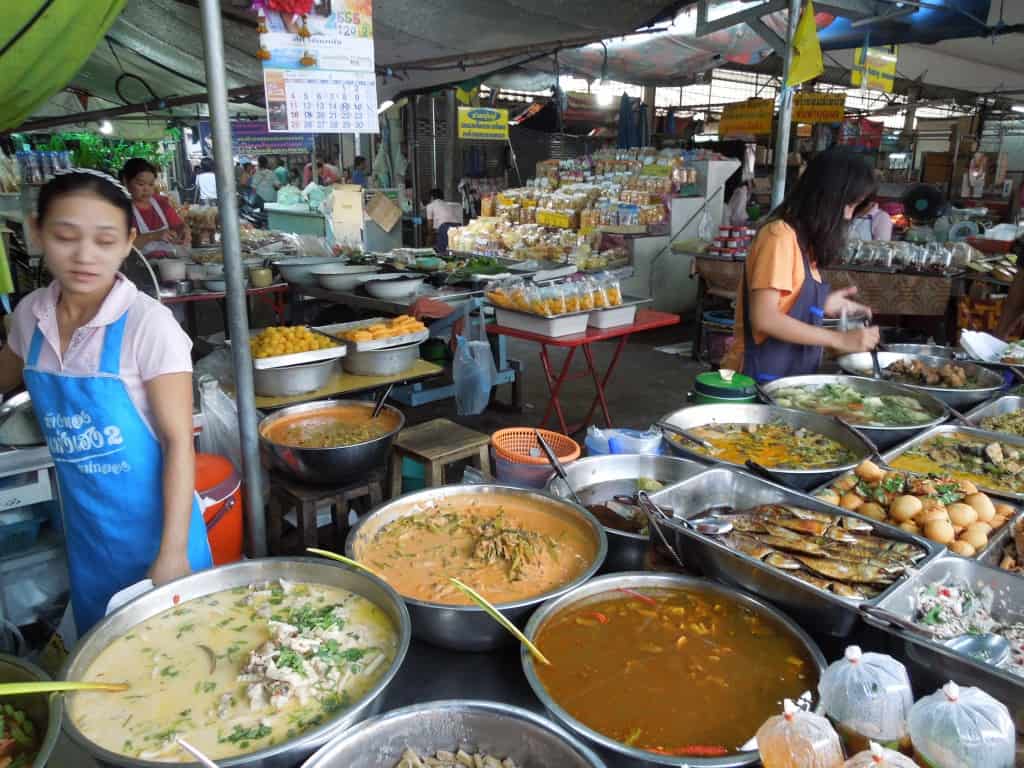
Let’s look at why this street vendor looks a little scary:
- Cooked and is being sold at room (or street) temperature
- The bowls are large and will take a while to sell, and they may even carry over products from the prior day
- They have a few too many options, which again leads to slow turnover of food and it sitting longer and growing more food bugs
- Nothing is covered, the chicken pieces are even sitting above the sauce. To me, this looks like stomach problems in the making.
Time Part 2
A second look at the time, this would be cooking time at temperature. It is possible to have a safe dish that never reaches that magic 160F (71C) degree number. If a dish cooks for a long enough time above 140F (60C) it rates as low-risk dish too.
The main reason I bring this one up is soup-based dishes are found all over Southeast Asia. Typically you have a large pot with broth and ingredients that are kept at a good temp maybe not 160F (71C) but probably over 140F (60C). Next noodles are added, awesomeness ensues. However, if it’s done in a different way, where the ingredients are not kept hot, look a little deeper before ordering a cup. Keep an eye out for meatballs at room temp. If they have a ton made up sitting somewhere room temp, it would cause some concern.
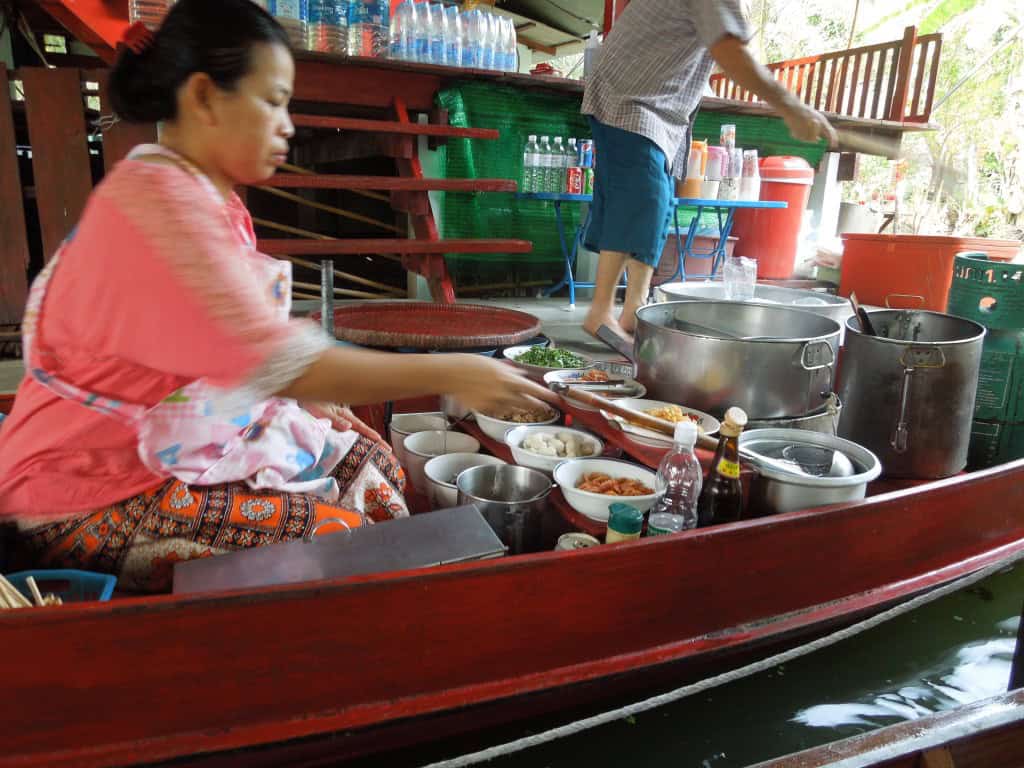
Why this stall looks good:
- All she sells is soup, one kind of soup, turnover should be high
- All ingredients are kept separately
- She looks very organized, she has a boat made to serve noodle soup, this is all she does and she is probably good at it
- It’s soup one of the safest meals because it is generally kept very hot
- She only has a small pile of pork balls and they should turn over quickly
Cold Street Food Stuff
The main items that come to mind here are fruit and smoothies. You have two enemies in the battle of safe fruits: Ice and clean equipment (knives, blenders, etc.) Where ice can get you in trouble is when it is made with bad water or the ice is stored in an old contaminated cooler.
If you can drink the tap water where you are, then you have less to worry about. If you can’t be sure, ask if the ice is made with filtered water and look for evidence of plastic bags the ice has been sold in (sometimes, if they want to sell it to you or just don’t understand, they may say ‘yes’ it was made with good water or they just say ‘yes’ to everything because they don’t speak any English).
This one got me once (I think) while in Costa Rica, making for a very rough second half of the trip. We ordered smoothies for breakfast one day, and from best, we can determine something was funky in them.
Watch out for bad ice while drinking too, as it melts into your rum & coke it can get you too (the rum does help some though). The safest drink is typically beer, it can be years old and not hurt you as long as it is sealed.
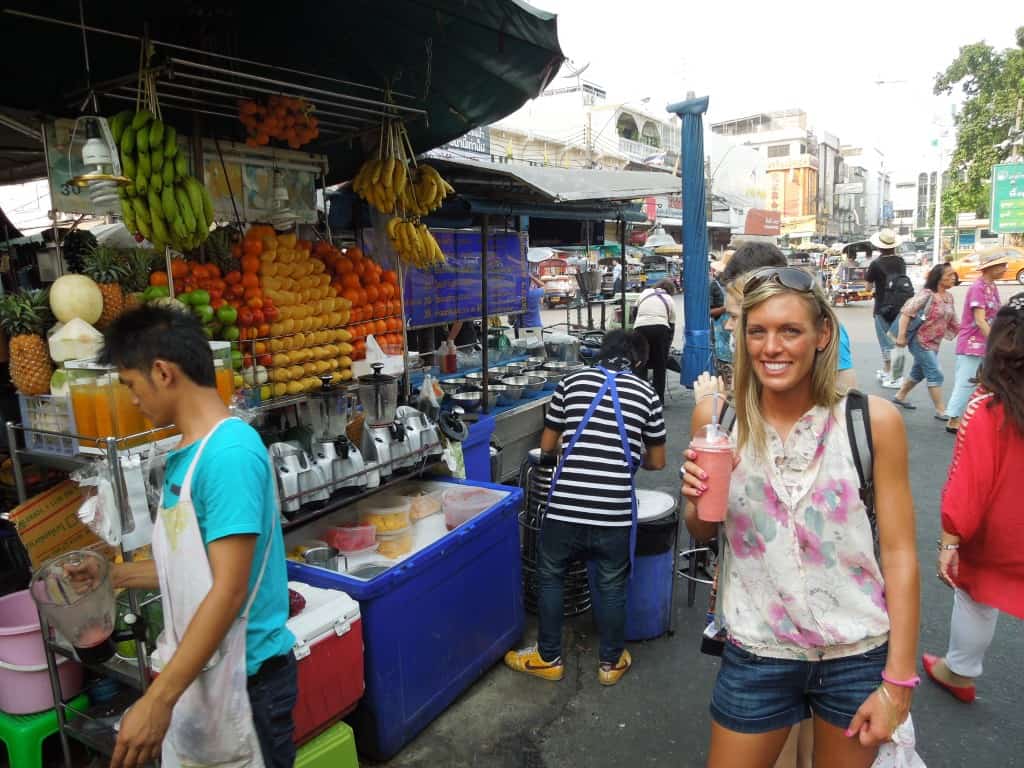
Why this smoothie stand passes my test:
- The fruit is all uncut and cut to order
- All fruits they serve are ones where you don’t eat the skin
- The coolers look new and clean
- The ice they are using is brought in sealed in bags
- Organized and popular
- Parked in a busy area with a high turnover of produce
Fresh Fruit
As a general rule of thumb, if you can peel it, you can eat it. Bananas, oranges, anything with nature’s very own wrapper, you are generally good to go. Any fruit where you eat the skin, like most berries, apples, etc., you need to be cautious. Fruits like these need to be disinfected in many countries around the world.
Many grocery stores will sell a concentrated disinfectant that mixes with water that will clean the fruits. Personally, I find this to be more of a production than it’s worth and generally just avoid these fruits. Plus, I don’t like the thought of eating chemicals that kill bacteria on my strawberries.
Included in the category are also vegetables because they are usually raised in the same soils that contain high levels of bacteria. Lettuce is of high concern because it is generally eaten raw. Other vegetables that are cooked would follow the same rules as the meats above, if it gets hot enough it will be safe. Generally, the bacteria are on the surface, and most vegetables, when cooked, will reach high enough temperatures.
The final lookout for fruits and smoothies is the equipment. This is not nearly the danger that undercooked foods are, but it still can get you if the vendor is careless. Things to watch: broken or very old coolers contaminating ingredients, blenders not being broken down and cleaned often, and cutting boards used for both cooked and uncooked items. Some of this you may not know, like when stuff was last cleaned, but use some judgment.
If the stand looks to be kept in good order, it may give some insight into the rest of the cleaning. One last fruit item that everyone seems to hit is pre-cut fruits. This one goes back to the time issue for me. If it is cut in front of you, I don’t see as much of an issue. On the other hand, if a nice lady approaches you with a bag of warm fruit slices in a little baggie, RUN!
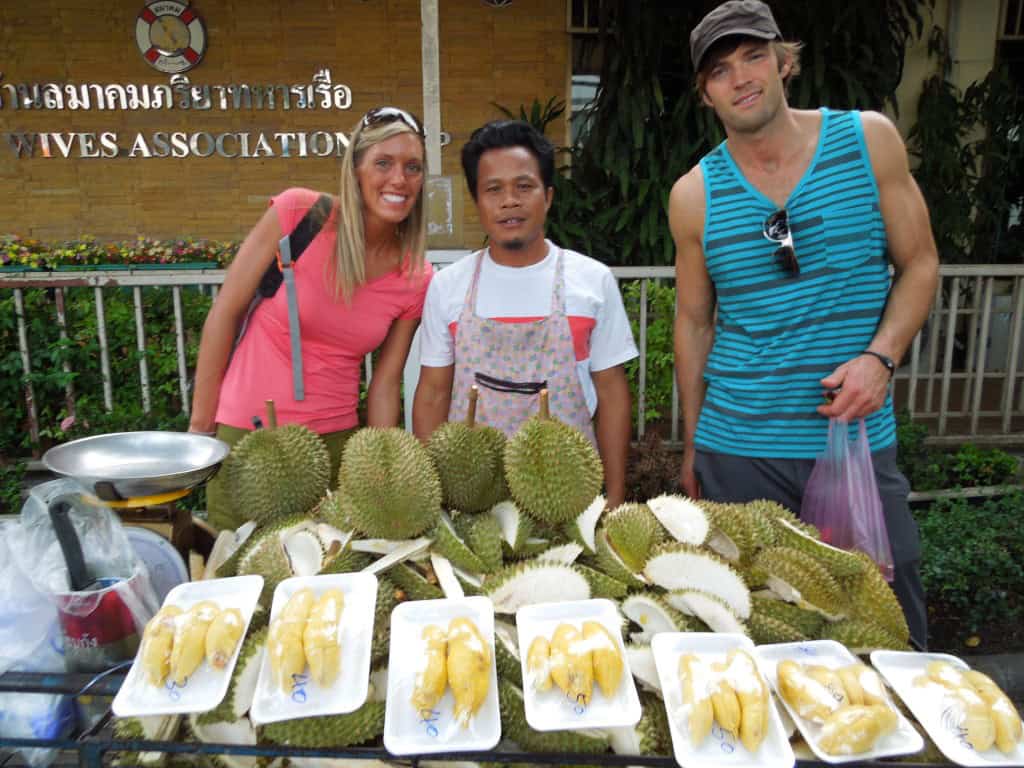
Dried Products
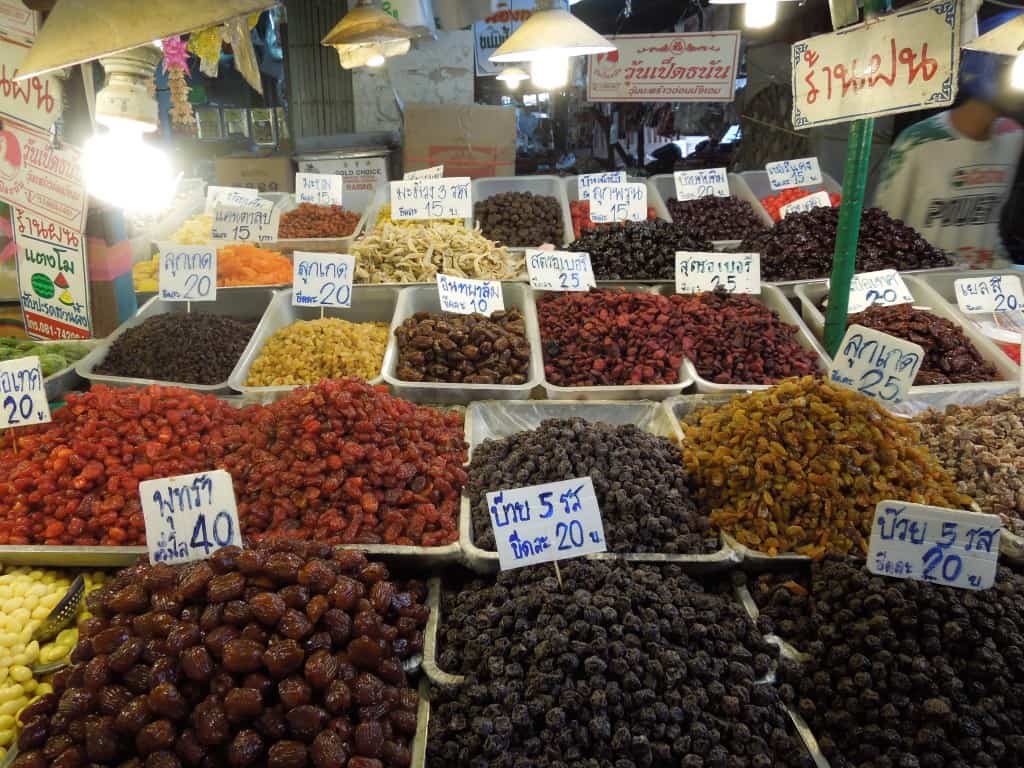
One of my favorite things for a long bus ride while traveling is dried veggie/plantain chips. I usually never worry about these because the bugs that get you sick need water in the food in order to grow. Dried foods won’t allow for the bug population to get big enough to hurt you. Examples of these you may run into on the road are:
Dried fruits, all kinds of chips, seeds (pumpkin, watermelon, ect.), even dried bugs, like crickets, fit this category. The only pitfall with dried goods is if they are not dried enough and are soggy. I haven’t really encountered soggy stuff, but I guess it could happen. If it is soggy it could have the moisture content to allow for food bug growth.
My safe list (generally)
- Items made to order
- Popular stalls
- Soups
- Dried products (fruits, chips, etc.)
My Stay away list:
- pre-made meals
- vendors with uncooked food next to already cooked items
- Dirty, under cleaned stalls
- Stalls ran by younger people who don’t look like they care (subjective, sorry)
Stall by Stall Basis
There are many articles floating around about the safety of street vendors by country. They will rank the country as a whole and give them a grade. I put this together so you can evaluate food on a vendor by vendor bases. It’s more important to evaluate a street cart on the facts above rather than skipping eating the street food in an entire country based on an overall rating.
If this post keeps just one person off the toilet while traveling then I am happy I wrote it. Eating from the street is in my opinion, the best way to see the local culture. From Jamaica to Jakarta we eat food from the street as often as we can. Don’t be scared. Just think, all of the things I said to look out for, you can’t even see in the kitchens of a restaurant…
